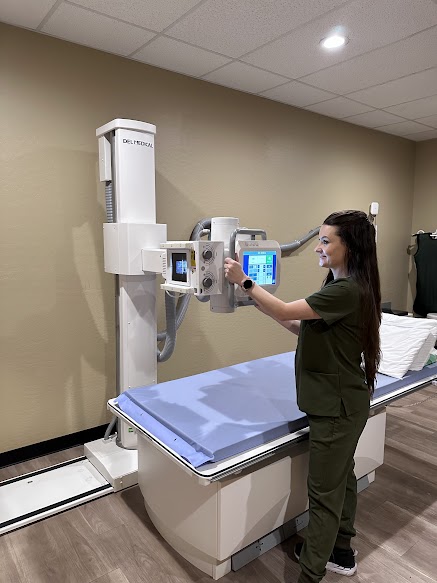What To Expect
During your fluoroscopy procedure, the technologist will help position you sitting, standing, or lying on a table depending on what is being studied. You’ll be able to talk to the technologist during the exam. Many patients want to know how long a fluoroscopy takes. Most exams are quick, typically taking 15–30 minutes depending on the type of study.
After the procedure, you can return to normal activities right away. Be sure to drink plenty of fluids, especially water, for the next 24 hours, to help flush the contrast material from your body.
Benefits and Safety
- Quick and painless procedure
- Non-invasive imaging test
- Lower radiation exposure thanks to digital imaging technology
- Safe contrast use — your care team uses the lowest amount needed and only for as long as necessary
Fluoroscopy is a valuable tool that helps doctors diagnose conditions and guide treatments safely and effectively. Many patients search for what is fluoroscopy imaging to understand how this test works and what it shows.
When Fluoroscopy Is Used
Fluoroscopy uses in medicine include evaluating the digestive system (such as a barium enema for the colon), as well as:
- Placing or adjusting catheters
- Urology and orthopedic procedures
- Implanting cardiac devices
- Angiograms (blood vessel imaging)
This broad range of applications is why many patients look for information about a fluoroscopy procedure in Arizona when choosing a local imaging center.
Types of Fluoroscopy Procedures
- Lumbar Puncture – Collects cerebrospinal fluid for testing.
- Myelogram – Uses contrast in the spinal column with CT imaging to check for nerve issues, spinal narrowing, or disc problems. Often used if MRI is not an option.
How Much Does a Fluoroscopy Cost in Arizona?
If you’re wondering how much a fluoroscopy costs in Arizona, the price can vary depending on the type of exam, whether contrast dye is used, the area of the body being examined, and your insurance coverage, co-pay, or deductible.
Many patients choose outpatient imaging centers like Arizona Diagnostic Radiology to receive the same high-quality fluoroscopy exams at a fraction of the price. According to the National Institute for Health Care Reform, community-based imaging centers may charge up to 50% less than hospital outpatient departments for identical procedures (source).
Choosing an outpatient facility helps patients save money, get faster scheduling, and enjoy a comfortable experience, all without sacrificing accuracy or quality.
Arizona Diagnostic Radiology offers affordable fluoroscopy in Arizona, with advanced technology and expert radiologists delivering precise, reliable results you can trust.








